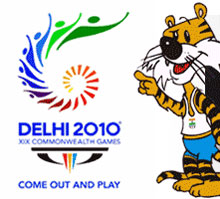The 2010 Commonwealth Games (CWG) in Delhi from October 5 to October 14 were orchestrated in typical Indian style. Until the eleventh hour, nothing was ready. There were fears that the event would have to be called off. Charges of corruption were rampant. (After suspending probes during the period of the Games, several investigative agencies have been unleashed again.) The facilities were reported to be way below acceptable standards. The Scottish delegation found dogs in their beds in the Games Village; the South Africans found a snake. But, in the end, it was a superb show. “Commonwealth Games 2010 finish with India triumphant,” said the London Guardian.
Prior to the games, former Union sports minister Mani Shankar Aiyar had been particularly trenchant in his criticism. “By having an 11-day jamboree in New Delhi, the idea that you can become a sporting nation is nonsense,” he told newsmagazine Tehelka some time ago. (Aiyar was forced out of his ministerial post because of his opposition to the Games.) “Even if a percentage of the money spent on the CWG had been pumped into real sport, we would have been producing champions.”
Today, Aiyar is unrepentant. “The CWG has denigrated India’s image,” he told The Times of India. “Rs. 70,000 crore to get us a bad name.”
A Waste of Money?
According to Aiyar, the CWG exercise cost more than US$15 billion (Rs. 70,000 crore). Melbourne, where the Games were held four years ago, spent only US$1.4 billion. (The figures in both cases vary enormously depending on what is added to the total.) Sandeep Bamzai, senior editor at TV news channel Headlines Today and the author of Guts and Glory: The Bombay Cricket Story, estimates that the actual spending is even higher. “It will all come out now,” he says. “This is one time that the charges of corruption and diversion of funds will not be brushed under the carpet.” Bamzai’s complaint is that a lot of the money spent will be of no use. “The investment in the Metro, the roads, the bus transport system and certain other infrastructure will certainly help the people of Delhi,” he says. “But in the absence of a sporting culture, who is going to use the new stadiums and the ones that have been refurbished at great expense? So far, they were haunted by criticism and complaints. Now they will be ghost stadiums.”
According to an August 5 report by the organizing committee on the status of preparedness for the CWG, the Delhi government was spending US3.3 billion on the city infrastructure. Several central ministries together had a budget of US$1 billion plus. (The original budget for the Games — allocated in 2003 — was a paltry US$500 million.) Against this, the direct revenue generation from broadcasting, sponsorship and ticketing was estimated to be US$500 million. That sounds doubtful, says the Delhi-based Hazards Centre, a non-governmental organization. “The total cost of the Games to the city remains shrouded in mystery,” adds a recent Hazards report.
The difference over the actual expenditure on the Games is also because the private sector has put in a lot of money and this is obviously not reflected in the government’s tally. At times, this becomes difficult to apportion. Several new hotels had come up in Delhi and the neighboring Gurgaon to cater to the expected 50,000 foreign and 140,000 domestic visitors. While Gurgaon, which has developed into the MNC capital of the country (most new multinationals are headquartered there), will have fewer problems, the new hotels in Delhi will not justify the investment. The occupancy numbers are not in yet, but tourism during the CWG did not live up to early expectations. Tour operators and travel agencies (and nearby destinations like Agra, home to the Taj) had also spent a lot of money in beefing up infrastructure. They, too, are sitting on losses.
Other private players have contributed in support services. The Sahara Group, which has interests in finance and real estate and is the official sponsor of the Indian cricket and hockey teams, pumped in more than US$2 million in hospitality-related activities. It also refurbished the guest rooms at the Games Village. “The CWG is a national festival,” says Subrata Roy Sahara, chairman of the group. “We took it as our duty to make it a success at this time when India is rising as a superpower.”
Problems of Brand Image
Opinion is divided whether association with the Games will be a positive or a negative. Thanks to the widely reported corruption and delays, the biggest losses are in terms of the country’s brand image. In the month leading up to the Games, every Indian newspaper and TV channel was full of reports of how India had missed all deadlines. There were suggestions that the Games be called off. The Games’ successful conclusion produced temporary euphoria. But with corruption investigations in full swing, observers are now doubting that success. “The enthusiasm for these projects owes more to the possibilities of corrupt gains rather than their professed purposes,” says Rajesh Chakrabarti, assistant professor of finance at the Hyderabad-based Indian School of Business (ISB). “One must balance the questions of improving the daily livelihood of the common man with the so-called national prestige that only the pampered urban elite care about.”
In the short term, critics say, the CWG was a financial disaster. According to the Hazards Centre, every such event is. Says its report: “The Hazards Centre had examined the performance of the Olympics and found that, beginning from Mexico in 1968, virtually every city that had hosted such an event had plunged into debt for the next 25-30 years. The Games never pay for themselves; it is public money that falls into the hands of private businessmen.” Developers, real estate agents, construction companies, and people at the high end of the tourism, advertising, marketing, and hospitality industries rake in profits, adds the report.
In Delhi, there were additional problems. The security concerns following terrorism threats didn’t help. Some top athletes pulled out. Tourists didn’t come. Advertisers, even public sector units, withdrew sponsorships. And the government scuttled all chances of a last minute revival in revenue by decreeing that the closing ceremony telecast should not have any ads. Says Bamzai, who puts the expenditure on the CWG somewhat higher than Aiyar’s estimate: “It was a colossal waste of money.”
Chakrabarti of ISB agrees. “While such events bring about some temporary visibility and tourism flows and improve infrastructure somewhat, if done in a proper location — not Delhi, where the disruption of normal life would more than offset such gains — the money spent can be used in a much better way in a country with three-quarters living below US$2-a-day income,” he says. “Even when it comes to sports, there are better ways of promoting it.”
“The easy answer [to the question of whether the Games are necessary] is ‘no.’ We do not need to spend this kind of money as there are more pressing issues,” says Harish Krishnamachar, senior vice-president, South Asia at the World Sport Group (WSG), a leading sports marketing, media and event management company in Asia. “However, my belief is that these are all issues that have to be dealt with and not necessarily sequentially. As a significant member of the world economy, it is imperative that we drive progress on multiple fronts. The ability to stage events of this scale is a signature that demonstrates to the world the strength and presence that we command.”
Good Outcome, but Poor Planning
Bibek Debroy, professor at the Delhi-based Centre for Policy Research (CPR), says that there are no easy answers; it’s not all black and white. “I believe that 50% of the expenditure would have happened in any case,” he notes. “What is important is the legacy left by the Games, more notably the transport infrastructure. The rest of it is intangible. There is a debate about the remaining 50% that should have been spent elsewhere, the opportunity cost of that expenditure. Delhi has got the kind of transport infrastructure it needed but not necessarily the integrated planning that it needed.”
If there is a debate about the short-term impact, the medium term has people taking more radical stands. The organizing committee of the CWG claimed in its defense that the jamboree would help create jobs. “The CWG will add 2.5 million jobs and US$5 billion to the Indian economy in the next few years,” says K.V. Thomas, Union minister of state for agriculture and consumer affairs. “According to my information, 80% of the expenses have been on account of infrastructure development, and when infrastructure improves the city will definitely improve. Tourism to the city will increase and the capital city needed these improvements.”
Bamzai disagrees. “The job creation — and it is not on that scale — is purely temporary.” Adds Debroy: “Job growth is of two types: transient and permanent. Permanent jobs happen on account of the growth of the transport system. The multiplier effect of increase in transport infrastructure is permanent. Jobs that happen in the construction industry and in the tourism sector are transient.”
Tourism has not delivered. But minister Thomas is confident. “Delhi will get the benefit of better infrastructure,” he says, reflecting on his experience as a state-level minister. “I was in charge of tourism in Kerala, and I feel Delhi will definitely benefit as a result of the Games.”
There is a business angle, too. Some athletes may have stayed out of India, but business participation didn’t suffer. Coinciding with the Games, the Commonwealth Games Business Forum had seminars and international partnership events on medical value travel, emerging trends in IT and IT-enabled services (ITeS), luxury goods, mining, and a conclave on Commonwealth Infra-investment. These were orchestrated by apex chambers — the Federation of Indian Chambers of Commerce and Industry (FICCI) and the Confederation of Indian Industry (CII).
Need for a Sporting Culture
Sports took center stage during the event. At the FICCI Global Sports Summit titled “Turf 2010,” the business potential was rated very high; however, Indian spending on sports is very low. The vociferous criticism of the CWG — industrialists such as Azim Premji of Wipro have been acerbic about the waste of money — indicates that sports is still regarded as a luxury. Bamzai, who spoke at Turf 2010, says India lacks a sporting culture. Another speaker at the event added: “Play is fun. Sports is organized play. India just plays.”
According to a FICCI report, global spend on sports is projected to rise from US$114 billion in 2009 to US$133 billion in 2013. (These are projections from a PricewaterhouseCoopers — PwC — study.) “While sport sponsorship in the Asia-Pacific region is projected to grow at 3.9% between 2010 and 2013, growth in India is expected to be higher as India plays host to global sporting competitions like the CWG and [because of the increase in the] spending power of the average Indian.”
FICCI also feels that there is grassroots support for sports that isn’t very apparent. The country is getting richer. Per capita income is growing. And people need an outlet for national pride. “As economies grow and people are increasingly secure in the fact that they need not worry about survival, they move towards expressing themselves, and sports forms a method of this expression,” says Krishnamachar of WSG.
Links between Medals Won and GDP
Now, there is talk of the country bidding to host the Olympics, just as China has done. And as India’s sporting culture develops, some feel the country could even move ahead in its Olympic medal tally.
Studies have shown that there is a linkage between per capita GDP and sporting performance. PwC has published three reports since the summer games at Sydney in 2000 and has come up with very accurate predictions. Daniel Johnson of the economics department of Colorado College has been using economic factors to predict a country’s Olympic medal tally with 90% plus accuracy. It’s not just the Olympics; research by Daiwa Capital Markets shows that hosting the FIFA World Cup increases a country’s GDP by 0.5%.
Opinion in India is divided on the correlation. “It is well established that richer nations excel in sports,” says Chakrabarti of ISB. “Research published in the Review of Economics and Statistics has shown that when you take into account GDP of countries, it dramatically improves the prediction on the medal tally of the model rather than just going by population. But GDP alone is not enough. Forced requisition of resources as in former Communist bloc countries (and to some extent China) matters equally, if not more.” But that, he underlines, is a connection between GDP and medals. Setting up of sporting infrastructure, which the CWG organizers feel will be a catalyst, has nothing to do with it. “The link between sports facilities and economic activity is a myth that has been long debunked by empirical analysis,” he explains.
“There is no evidence anywhere in the world that the sports infrastructure that comes up is fruitfully used by the host country,” says Debroy of CPR. “Even after the Manchester Games (CWG 2002) transport and urban planning benefited but sports got no advantage.”
A FICCI survey in Delhi has found that the citizens of the national capital region are more optimistic. The poll was conducted when the problems — including water-logging and outbreaks of dengue, malaria and conjunctivitis — were at their worst. Surprisingly, 50% felt that hosting the CWG in the country would give a boost to the economy and would lead to the overall development of the country in the long run. There was greater optimism on the jobs front with 61% saying that the CWG would create job opportunities in the country.And a substantial 74% felt that the new infrastructure would make Delhi a better place in which to live.
For the medals to come rolling in — as they have during the CWG — there needs to be a move away from cricket, observers note. Recent research at Monash University in Australia shows that when India’s cricket team loses a one-day match, the stock market takes a beating. India is slated to become the world’s third largest economy by 2030 and the second largest a decade later. Will that change the games people play?



